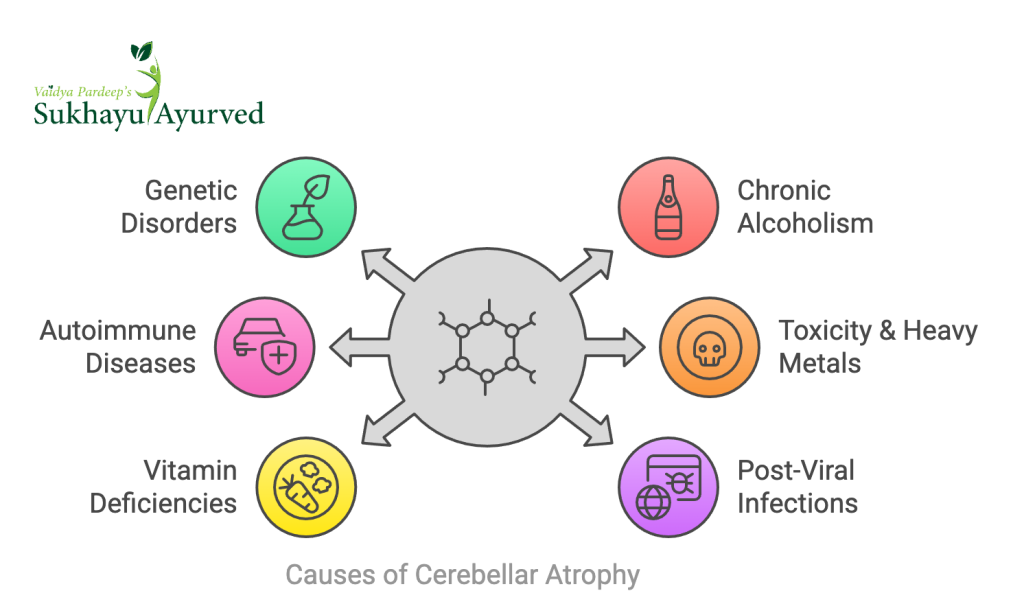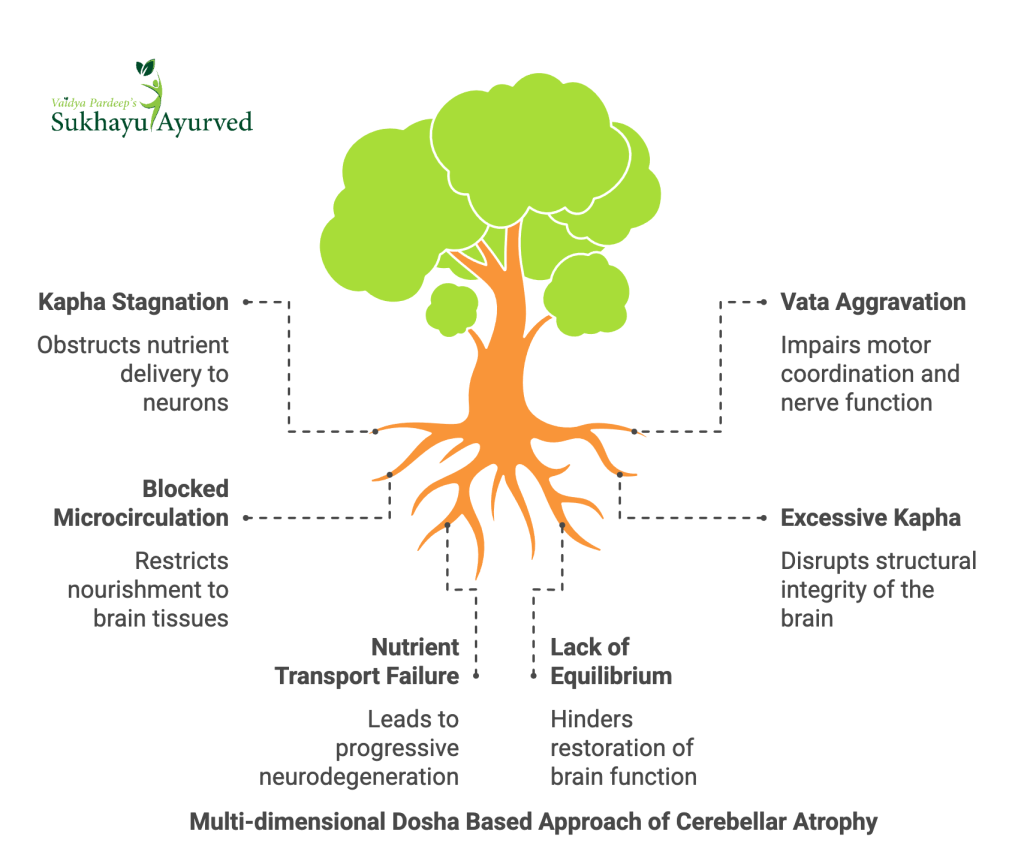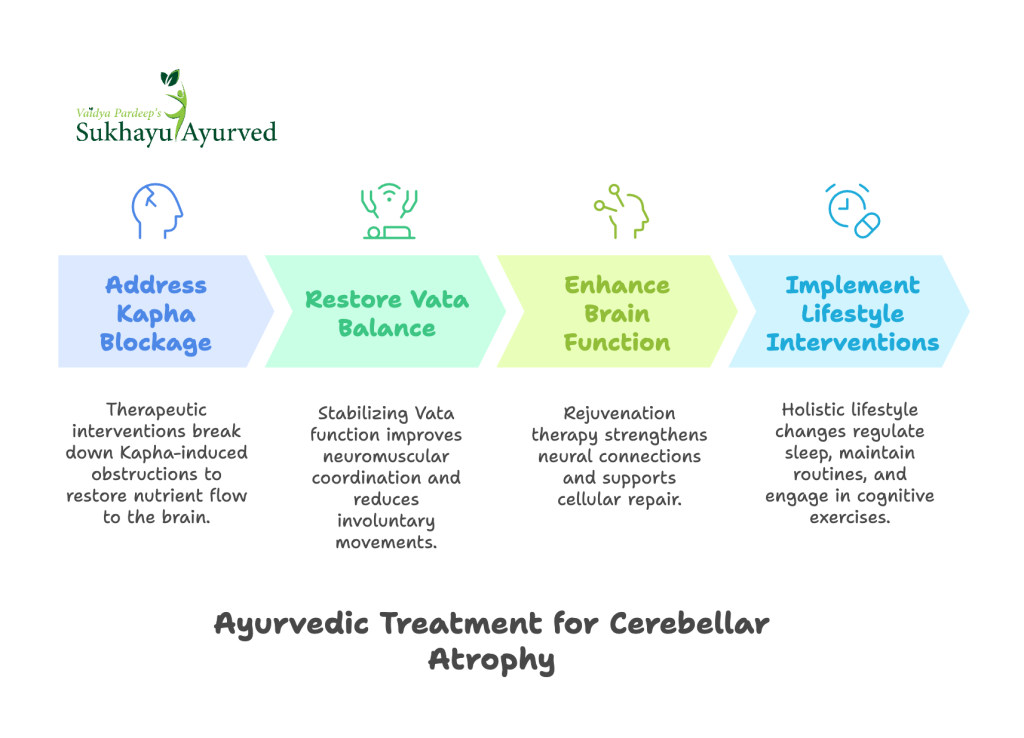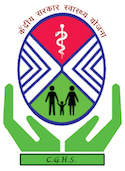Understanding Diffuse Cerebellar Atrophy
Diffuse Cerebellar Atrophy is a progressive neurological condition. This condition affects the cerebellum. Cerebellum is last part of the brain. This region of the brain works for motor coordination, balance, and precise movement control. The deterioration of cerebellar tissue results in movement disorders, loss of equilibrium, slurred speech, and cognitive decline. In conventional medicine, this condition is often classified under neurodegenerative disorders, with treatment primarily focused on symptomatic relief through physical therapy and medications aimed at compensating for motor deficits. However, these approaches do not reverse the structural and functional deterioration of the cerebellum. This all can guide further to ayurveda treatment of diffuse cerebellar atrophy
In contrast, Ayurveda provides a systematic and scientific approach to healing by recognizing the disease as a result of impaired nourishment to the brain due to internal systemic blockages. The fundamental objective in Ayurvedic management is not merely compensating for lost functions but restoring neurological integrity by improving nourishment and circulation in brain tissues.
Causes and Risk Factors of Diffuse Cerebellar Atrophy

Modern Causes of Cerebellar Atrophy
- Genetic Disorders: Spinocerebellar ataxia, mitochondrial disorders.
- Chronic Alcoholism: Leads to thiamine deficiency, damaging brain cells.
- Autoimmune Diseases: Multiple sclerosis, celiac disease affecting the cerebellum.
- Toxicity & Heavy Metal Exposure: Lead, mercury, or drug-induced neurotoxicity.
- Vitamin Deficiencies: B12, Vitamin E, and thiamine deficiency.
- Post-Viral Infections: Certain viral infections may lead to progressive cerebellar damage.
Ayurvedic Perspective on Causes
- Prakriti (Constitution) Imbalance: Some individuals are more prone to neurological disorders due to their genetic Vata-Pitta dominance.
- Poor Digestive Health (Agnimandya): Leads to the formation of toxins (Ama), affecting the nervous system.
- Unbalanced Lifestyle & Poor Diet: Excessive stress, irregular sleep, and lack of nourishing foods worsen neurodegeneration.
- Emotional & Mental Stress: Chronic stress depletes Ojas, leading to brain dysfunction.
👉 By understanding these causes, Ayurveda focuses on treatment approaches that slow down neurodegeneration and improve brain health.
Ayurvedic Pathology of Diffuse Cerebellar Atrophy

Ayurveda attributes neurodegeneration to an imbalance in the three fundamental bio-forces—Vata, Pitta, and Kapha—governing the body’s physiological functions. In the case of cerebellar atrophy, the primary pathology involves a blockade within the microcirculatory channels (Srotas), restricting the nourishment of neural tissues.
This condition is not solely a degenerative disorder but a progressive failure of nutrient transport to the brain. Ayurveda identifies Kapha as the fundamental force responsible for maintaining structural integrity and nourishment in the body. However, when Kapha stagnates and becomes excessive in nature, instead of supporting brain function, it obstructs the fine channels (Srotas) responsible for delivering nutrients to the neurons. Over time, this lack of nourishment results in atrophy of the cerebellum, affecting coordination, muscle tone, and cognitive processes.
At the same time, Vata (responsible for movement and nerve function) becomes aggravated due to this depletion, leading to impaired motor coordination, tremors, and imbalance. This interplay between Kapha-induced blockage and Vata dysfunction underlies the progressive nature of cerebellar atrophy.
Thus, the Ayurvedic approach does not merely attempt to compensate for the loss of neurological function but focuses on restoring the natural equilibrium between nourishment and neural activity by correcting the blockages and ensuring optimal nutrient flow to the brain.
Ayurvedic Approach to Treatment of Diffuse Cerebellar Atrophy

1. Addressing Kapha Blockage to Restore Nutrient Flow
The first step in the Ayurvedic management of Diffuse Cerebellar Atrophy is to dissolve and clear the Kapha – induced obstruction in the micro-channels (Srotas) responsible for nourishing neural tissues. Unlike conventional medicine, which treats neurodegeneration as an irreversible process, Ayurveda emphasises reviving dormant neural pathways and restoring lost function by ensuring an uninterrupted supply of essential nutrients to the cerebellum.
For this, specific therapies are employed to liquefy and expel accumulated Kapha, allowing vital substances to reach the brain and nourish the neurons. When these blockages are cleared, the cerebellum regains its ability to communicate effectively with the rest of the nervous system, leading to improved coordination, balance, and cognitive function.
2. Restoring Vata Balance to Improve Motor Control
Since Vata governs all movement-related functions in the body—including reflexes, muscle control, and nerve conduction—its stability is crucial for preventing further deterioration and improving movement coordination. However, due to the long-standing obstruction of Kapha, Vata remains in a state of heightened activity, resulting in shaky movements, tremors, and loss of voluntary muscle control.
Ayurveda addresses this by employing techniques that stabilize and regulate neural impulses, ensuring smooth transmission of signals from the cerebellum to the muscles. By restoring synaptic communication within the nervous system, the body gradually regains control over fine motor skills, reducing tremors and enhancing balance.
Furthermore, correcting Vata imbalance improves blood flow to the cerebellum, enhancing oxygenation and metabolic activity in the affected areas of the brain. This plays a crucial role in reducing neuroinflammation, improving neural resilience, and preventing further atrophy.
3. Enhancing Brain Function with Rejuvenation Therapy
While addressing Kapha blockages and stabilizing Vata function are essential steps, true neurological recovery requires deep cellular-level nourishment and regeneration. Ayurveda employs neuro-regenerative strategies that focus on:
- Strengthening neural connections to enhance coordination and stability
- Supporting the cerebellum with vital nutrients that promote cellular repair
- Ensuring long-term functional improvement rather than temporary symptomatic relief
Through specific techniques that stimulate the nervous system, Ayurvedic therapies work to rebuild atrophied neural tissues and improve synaptic plasticity—the brain’s ability to rewire and form new neural connections.
This approach not only slows down disease progression but also lays the foundation for functional recovery, enabling patients to regain lost abilities.
4. Holistic Lifestyle Interventions for Long-Term Neurological Health
Healing from Diffuse Cerebellar Atrophy is not limited to therapeutic interventions alone. Daily habits, dietary choices, and mental health management play an integral role in stabilizing and improving neurological function.
- Regulating sleep patterns to support neuroplasticity and brain detoxification processes.
- Maintaining a structured daily routine to ensure proper nervous system functioning.
- Engaging in guided movement-based therapies to improve motor coordination and prevent muscular atrophy.
- Incorporating cognitive exercises to enhance focus, memory, and mental clarity.
By integrating these lifestyle changes into daily life, the nervous system adapts to progressive healing, preventing the rapid worsening of symptoms and improving the overall quality of life.
The Scientific Basis of Ayurveda’s Approach
Ayurveda’s emphasis on removing blockages, stabilizing neural function, and stimulating cellular regeneration aligns with modern scientific findings that highlight the importance of neurovascular coupling—the process by which neurons receive an adequate supply of blood and nutrients.
Research indicates that progressive neurodegeneration in conditions like cerebellar atrophy is closely linked to metabolic dysfunction in neurons due to inadequate nutrient flow. This directly supports Ayurveda’s emphasis on clearing obstructed channels to restore optimal nutrient circulation.
Furthermore, studies on synaptic plasticity and neurogenesis suggest that brain cells, even in neurodegenerative conditions, retain the ability to reorganize and adapt when provided with the right nourishment and stimulation. Ayurveda’s rejuvenation therapies actively work toward enhancing this natural ability of the nervous system, offering a promising alternative to conventional approaches that rely solely on symptomatic management.
The Ayurvedic Path to Neurological Healing
Diffuse Cerebellar Atrophy is a progressive condition, but Ayurveda offers an informed, evidence-based approach to restoring function rather than merely managing symptoms. By understanding the role of Kapha blockages in restricting neural nourishment and the interplay of Vata imbalance in worsening motor dysfunction, Ayurveda provides a clear and logical treatment pathway.
Instead of accepting neurodegeneration as irreversible, Ayurveda focuses on rekindling lost neural functions, re-establishing synaptic communication, and systematically restoring lost abilities.
Through a combination of targeted neurological therapies, regenerative techniques, and structured lifestyle modifications, Ayurveda provides a realistic and sustainable path to healing.
If you or a loved one is struggling with Diffuse Cerebellar Atrophy, exploring Ayurveda’s comprehensive approach may provide an opportunity for improved function and enhanced quality of life.
📢 To learn more about Ayurvedic neurology treatments, visit Sukhayu Ayurved
📞 For a consultation, contact us today!

Telephone No.9050802060














